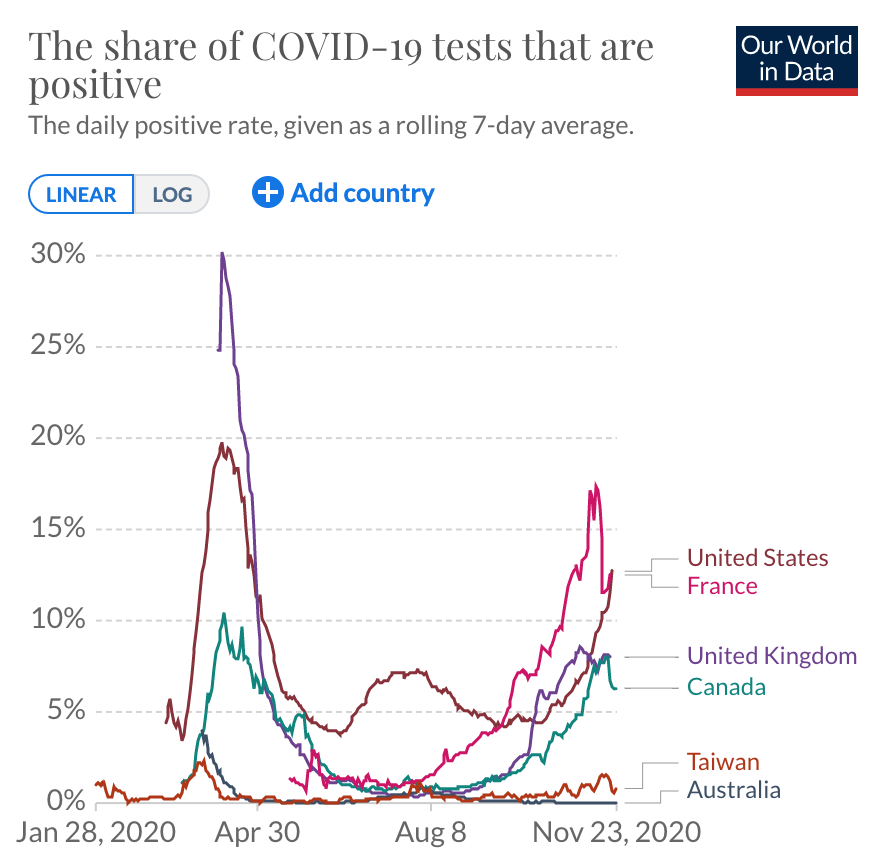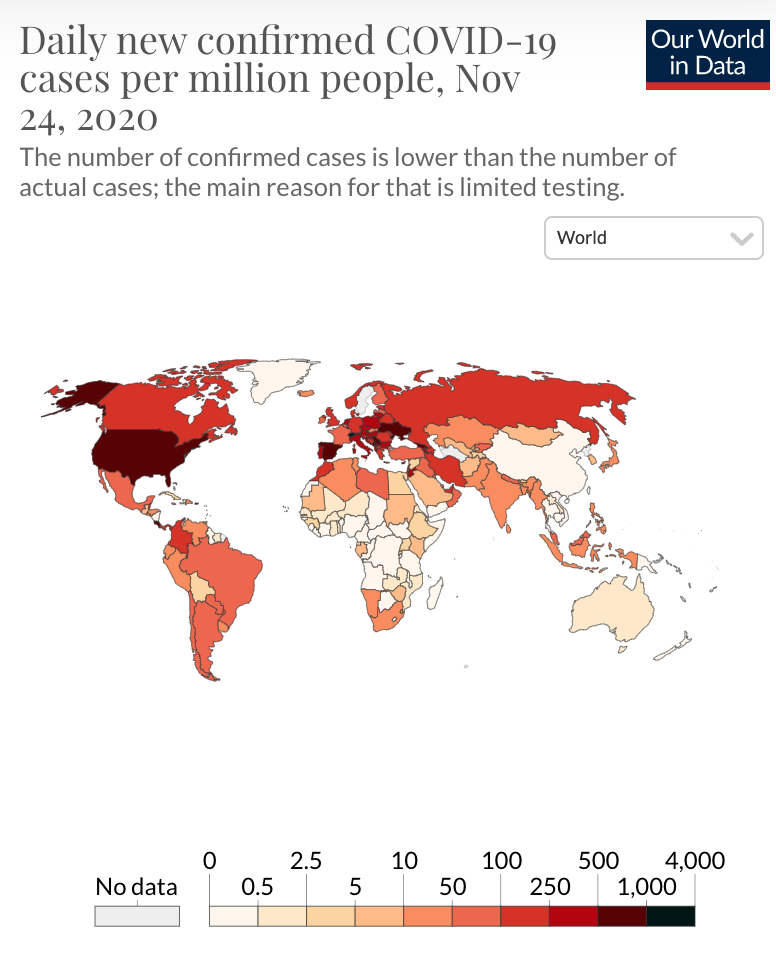This is the 14th in a series of articles on CoVid-19. I am not a medical expert, but have worked with epidemiologists and have some expertise in research, data analysis and statistics. I am producing these articles in the belief that reasonably researched writing on this topic can’t help but be an improvement over the firehose of misinformation that represents far too much of what is being presented on this topic in social (and some other) media.


NB: Sweden is a day behind in reporting; its latest report shows 350 cases/day/M (ie should be dark red not grey in map on right).
There has been much talk lately about the wisdom of the prevailing “yo-yo” approach to dealing with CoVid-19 — relaxing restrictions when cases, hospitalizations and deaths drop, and reimposing them when they rise to “unacceptable” levels.
The only reason this utterly failed policy is still being used in North America and Europe is that governments and public health organizations have been paralyzed by fierce antipathy to government, antipathy which has been repeatedly churned up since the 1980s by fear-driven conservatives and by uneducated citizens prone to believing fear-mongered conspiracy theories about “evil” governments.
So governments and health authorities are reluctant, even fearful, to impose any restrictions on the public until and unless the crisis reaches catastrophic levels. The violent knee-jerk responses of the right to even the modest restrictions that have been imposed (eg widespread death threats, occupations by heavily-armed right-wing “militias”, the blossoming of QAnon and other lunatic fringe anti-government conspiracy theory cults, and the attempted kidnapping and coup in Michigan), suggest that governments’ fear to act decisively is not entirely ill-founded.
As a result of this absurd policy, 11,000 Canadians, 275,000 Americans and nearly 1.5M people globally have needlessly died, and the pandemic is now spreading faster than ever.
In Canada, as a result of the use of the yo-yo strategy, as Andrew Nikiforuk reports, “hospitals in Alberta, Manitoba, Ontario, Saskatchewan and Quebec are almost overwhelmed, long-term care homes have once again become deadly hot zones, and a nation that committed $4 billion to be able to conduct 200,000 tests a day still struggles to do half that”.
The only viable alternative to the yo-yo strategy is a go-for-zero strategy, which has been successfully deployed in the so-called TANZANC countries (Taiwan, Australia, New Zealand, and Atlantic & Northern Canada). These democratic countries have essentially eliminated CoVid-19 within their borders, put in place stringent measures to prevent its re-emergence, and hence been able to restore “normal” life, and seen their economies quickly rebound as a result.
The Australian Grattan report shows what would be required for any democratic country to achieve similar success:
- Make zero cases the explicit goal for the country/state, and implement a specific, public plan to achieve that goal.
- That plan will likely include a complete lockdown for all ages until the number of reported new cases has been reduced to approximately 3 per day per million people. [Current level in the US is 500/day/M; in Canada it’s 120/day/M, but it was about 10/day/M for much of the summer before the recent surge]. Once the 3/day/M level has been achieved, certain specific low-risk, high-benefit activities can be permitted and encouraged. Additional easing can be permitted once new cases drop to 1/day/M people, and considerable further easing once zero new cases have been reported for a week.
- Everyone entering the country must be tested at the border and/or strictly quarantined for 14 days or until a negative test is confirmed.
- Stringent, properly staffed contact tracing and isolation must be in place for any cases that do arise. Non-cooperation and lying about exposure should be prosecutable. Lives depend on it.
- Testing must be easily and universally accessible for free, and test results must be able to be produced and communicated within 24 hours. The technology to do this exists; the capacity in most jurisdictions currently does not.
- Testing with digital attendance record-keeping and follow-up must be instituted in all public venues (restaurants, arenas etc). [Australia’s success means that up to 35,000 people can now attend stadium events with zero resulting cases.]
- Masks are mandatory in all public places in areas which have had recently-reported cases. In all other places they are optional.
- Economic supports for all those disadvantaged by restrictions must be available.
- Strict enforcement of quarantine must be maintained; no exceptions.
I can imagine the QAnon crowd getting apoplexy just reading this list. But it works. It has saved thousands of lives and enabled quick economic recovery in areas that have had the courage and resources to implement it.
What would it take to implement it in other areas? Obviously the more out-of-control the virus is in an area, the longer the lockdown and the greater the challenge. In most of the US, interstate border crossings are impossible to restrict and the resources simply don’t exist, so it wouldn’t be possible even if cases weren’t already 100 times or more the target 3/day/M rate for achieving the go-to-zero benefits. Maybe in Vermont and Hawai’i.
But in Canada, despite the upsurge, it’s still feasible. It took Victoria state in Australia nearly 2 months to reduce their spike from 80 cases/day/M back down below 3 (and it’s now zero on most days). So Canada could probably get its 120 cases/day/M down to below 3 within 90 days (by Feb 28) if we followed a national, strict, Grattan-style go-for-zero strategy.
If not, IHME projects the Canadian infection rate will soar to 360/day/M and nearly 30,000 more Canadians will die by that date, which is likely the earliest that a vaccine will start to be available in sufficient quantities for the population at large. A go-for-zero strategy could save 90% of those deaths, 27,000 lives. Not to mention the unknown long-term damage to those infected, and the strain on our hospitals and other institutions. Is that worth a 90-day lockdown? I would say so.
Probably the most important question (since Canadian and other governments know about this strategy and have refused to implement it), is whether CoVid-19 will teach us the lesson that this is the way to go next time. The next pandemic is surely coming, and while governments shrugged off the threat of SARS and MERS ten years ago, the number of pandemics per decade is accelerating as factory farms proliferate, and as exotic animal harvesting and encroachment into the world’s last wilderness areas grows exponentially. A pandemic with the transmissibility of CoVid-19 and the morbidity of SARS or MERS would (will?) kill billions. When it hits, we cannot afford to be unready. And unless trust in government and public health institutions in most of the world’s democracies can be restored, we will not be ready.





I agree with your strategic analysis.
I live in Hawaii. We endured several months of tourism at 1% of normal. I always wondered why we didn’t just go to supervised quarantine (which would have probably reduced tourism to 0%) and eradicate the virus. We would have lost the economic benefits of tourism, which are considerable, but the rest of the economy and life in general could have returned to normal.
Also, there is an inverse relationship between mortality and transmissibility. A quick internet search found a 2016 study of transmissibility that noted, “In particular, we determined that viruses with low host mortality, that establish long-term chronic infections, and that are nonsegmented, nonenveloped, and, most importantly, not transmitted by vectors were more likely to be transmissible among humans.” High transmissibility coupled with high mortality is not impossible, but it’s less likely.
Joe: I guess the question is what would happen to Hawai’i’s economy if you did that and then still had to quarantine all tourists until the vaccine had taken effect. With as much as 1/3 of the population there tourists in some months, the “rest of the economy” might look quite different pretty soon (as I understand it already has). That’s the paradox. It only works well if you don’t have to depend much on the rest of the world. What works in Taiwan, NZ & Oz doesn’t necessarily work elsewhere. In Canada for example we’re utterly dependent on the US for food, so while our border with them is “closed”, tens of thousands of truck drivers come across every day, no testing, no quarantine.
You’re right about the high mortality/high transmissibility curve. I wonder if that’s an evolutionary thing rather than an inherent thing. If high mortality/high transmissibility of viruses were the norm, we’d all be dead and not around to theorize about it.
This is just a thought, but it occurs to me there’s a strong cultural component to whether measures are successful. I think the word “democracy” is waved around a lot as if it’s a descriptor of freedom, and study you linked points out that the politicial system of the country is a red herring.
I could be way off but China and Taiwan share many cultural traits to do with obedience and duty, perhaps mixed up a bit with Taiwan having a less oppressive regime. I think NZ has a kinder culture from what I’ve gathered although it has suffered from neoconservative tendencies in the last 30 years – the old lowering of taxes and crippling public services – maybe going the other way now. I think Atlantic Canada – thinking of Nova Scotia, must be similar.
My response has been that the people suddenly getting upset about being told to wear masks have been perfectly happy to ask the government to do many other things, but being prevented from going to the shops or a restaurant is now a terribly oppressive. If there are problems with government power they were there already, plus “the government” is an abstraction you can’t really ascribe actions to. The point is the way people respond. And the distaste for the “government” is highly selective – lots of government is fine if it makes big investments in infrastructure for large corporations, but it’s suddenly crossed a line when you’re preventing from ambling around the mall for hours. Or giving disadvantaged people a few quid to stop them starving.
I can understand the frustration of “this would be straightforward to handle if people behaved rationally”, yet I think it’s been interesting to see how people’s attitudes have been revealed in different countries, or how compartmentalised thinking is. Also makes sense considering your “laws” from the last post…